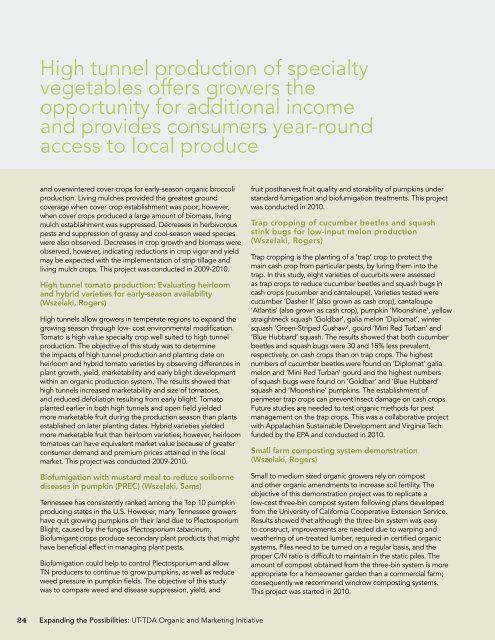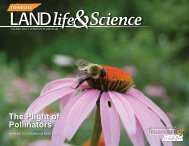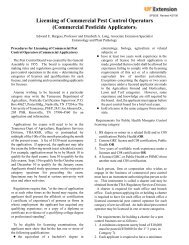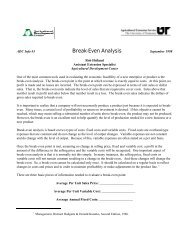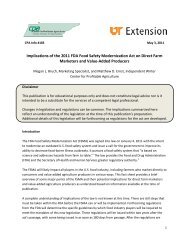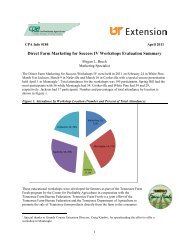EXPANDING THE POSSIBILITIES: - The University of Tennessee
EXPANDING THE POSSIBILITIES: - The University of Tennessee
EXPANDING THE POSSIBILITIES: - The University of Tennessee
You also want an ePaper? Increase the reach of your titles
YUMPU automatically turns print PDFs into web optimized ePapers that Google loves.
High tunnel production <strong>of</strong> specialty<br />
vegetables <strong>of</strong>fers growers the<br />
opportunity for additional income<br />
and provides consumers year-round<br />
access to local produce<br />
and overwintered cover crops for early-season organic broccoli<br />
production. Living mulches provided the greatest ground<br />
coverage when cover crop establishment was poor; however,<br />
when cover crops produced a large amount <strong>of</strong> biomass, living<br />
mulch establishment was suppressed. Decreases in herbivorous<br />
pests and suppression <strong>of</strong> grassy and cool-season weed species<br />
were also observed. Decreases in crop growth and biomass were<br />
observed, however, indicating reductions in crop vigor and yield<br />
may be expected with the implementation <strong>of</strong> strip tillage and<br />
living mulch crops. This project was conducted in 2009-2010.<br />
High tunnel tomato production: Evaluating heirloom<br />
and hybrid varieties for early‐season availability<br />
(Wszelaki, Rogers)<br />
High tunnels allow growers in temperate regions to expand the<br />
growing season through low- cost environmental modification.<br />
Tomato is high value specialty crop well suited to high tunnel<br />
production. <strong>The</strong> objective <strong>of</strong> this study was to determine<br />
the impacts <strong>of</strong> high tunnel production and planting date on<br />
heirloom and hybrid tomato varieties by observing differences in<br />
plant growth, yield, marketability and early blight development<br />
within an organic production system. <strong>The</strong> results showed that<br />
high tunnels increased marketability and size <strong>of</strong> tomatoes,<br />
and reduced defoliation resulting from early blight. Tomato<br />
planted earlier in both high tunnels and open field yielded<br />
more marketable fruit during the production season than plants<br />
established on later planting dates. Hybrid varieties yielded<br />
more marketable fruit than heirloom varieties; however, heirloom<br />
tomatoes can have equivalent market value because <strong>of</strong> greater<br />
consumer demand and premium prices attained in the local<br />
market. This project was conducted 2009-2010.<br />
Bi<strong>of</strong>umigation with mustard meal to reduce soilborne<br />
diseases in pumpkin (PREC) (Wszelaki, Sams)<br />
<strong>Tennessee</strong> has consistently ranked among the Top 10 pumpkin<br />
producing states in the U.S. However, many <strong>Tennessee</strong> growers<br />
have quit growing pumpkins on their land due to Plectosporium<br />
Blight, caused by the fungus Plectosporium tabacinum.<br />
Bi<strong>of</strong>umigant crops produce secondary plant products that might<br />
have beneficial effect in managing plant pests.<br />
Bi<strong>of</strong>umigation could help to control Plectosporium and allow<br />
TN producers to continue to grow pumpkins, as well as reduce<br />
weed pressure in pumpkin fields. <strong>The</strong> objective <strong>of</strong> this study<br />
was to compare weed and disease suppression, yield, and<br />
fruit postharvest fruit quality and storability <strong>of</strong> pumpkins under<br />
standard fumigation and bi<strong>of</strong>umigation treatments. This project<br />
was conducted in 2010.<br />
Trap cropping <strong>of</strong> cucumber beetles and squash<br />
stink bugs for low‐input melon production<br />
(Wszelaki, Rogers)<br />
Trap cropping is the planting <strong>of</strong> a ‘trap’ crop to protect the<br />
main cash crop from particular pests, by luring them into the<br />
trap. In this study, eight varieties <strong>of</strong> cucurbits were assessed<br />
as trap crops to reduce cucumber beetles and squash bugs in<br />
cash crops (cucumber and cantaloupe). Varieties tested were<br />
cucumber ‘Dasher II’ (also grown as cash crop), cantaloupe<br />
‘Atlantis’ (also grown as cash crop), pumpkin ‘Moonshine’, yellow<br />
straightneck squash ‘Goldbar’, galia melon ‘Diplomat’, winter<br />
squash ‘Green-Striped Cushaw’, gourd ‘Mini Red Turban’ and<br />
‘Blue Hubbard’ squash. <strong>The</strong> results showed that both cucumber<br />
beetles and squash bugs were 30 and 15% less prevalent,<br />
respectively, on cash crops than on trap crops. <strong>The</strong> highest<br />
numbers <strong>of</strong> cucumber beetles were found on ‘Diplomat’ galia<br />
melon and ‘Mini Red Turban’ gourd and the highest numbers<br />
<strong>of</strong> squash bugs were found on ‘Goldbar’ and ‘Blue Hubbard’<br />
squash and ‘Moonshine’ pumpkins. <strong>The</strong> establishment <strong>of</strong><br />
perimeter trap crops can prevent insect damage on cash crops.<br />
Future studies are needed to test organic methods for pest<br />
management on the trap crops. This was a collaborative project<br />
with Appalachian Sustainable Development and Virginia Tech<br />
funded by the EPA and conducted in 2010.<br />
Small farm composting system demonstration<br />
(Wszelaki, Rogers)<br />
Small to medium sized organic growers rely on compost<br />
and other organic amendments to increase soil fertility. <strong>The</strong><br />
objective <strong>of</strong> this demonstration project was to replicate a<br />
low-cost three-bin compost system following plans developed<br />
from the <strong>University</strong> <strong>of</strong> California Cooperative Extension Service.<br />
Results showed that although the three-bin system was easy<br />
to construct, improvements are needed due to warping and<br />
weathering <strong>of</strong> un-treated lumber, required in certified organic<br />
systems. Piles need to be turned on a regular basis, and the<br />
proper C/N ratio is difficult to maintain in the static piles. <strong>The</strong><br />
amount <strong>of</strong> compost obtained from the three-bin system is more<br />
appropriate for a homeowner garden than a commercial farm;<br />
consequently we recommend windrow composting systems.<br />
This project was started in 2010.<br />
Potential <strong>of</strong> biodegradable mulches for specialty crops<br />
produced under protective covers (Wszelaki, Martin,<br />
Hayes, Lee)<br />
This transdisciplinary research and Extension project on<br />
Biodegradable Mulches for Specialty Crops Produced<br />
Under Protective Covers, funded by NIFA’s SCRI program,<br />
is determining whether experimental spunbond nonwovens<br />
and leading commercially-available biodegradable mulches<br />
are <strong>of</strong> similar quality to conventional black plastic in both<br />
high tunnel and open field specialty crop production, and<br />
can safely biodegrade in the soil. In this 3-year study, a team<br />
<strong>of</strong> 17 scientists is evaluating biodegradable mulches in a<br />
tomato production system in three diverse regions <strong>of</strong> the U.S.:<br />
eastern <strong>Tennessee</strong>, central Texas, and western Washington. In<br />
addition, the team is evaluating the adaptability <strong>of</strong> six lettuce,<br />
strawberry and tomato cultivars to high tunnel production in<br />
these contrasting environments. In <strong>Tennessee</strong>, winter strawberry<br />
production has been shown to be a viable option for high tunnel<br />
growers. This project began in 2010 and is on-going.<br />
Evaluation and optimization <strong>of</strong> anaerobic soil<br />
disinfestation for <strong>Tennessee</strong> (Butler, Ownley, Wszelaki)<br />
Soil treatment by anaerobic soil disinfestation (ASD) is an<br />
alternative to soil fumigation with chemicals such as methyl<br />
bromide. Treatment by ASD involves the addition <strong>of</strong> a labile<br />
carbon (C) source to the soil (to stimulate rapid microbial growth<br />
and respiration), tarping with plastic to limit gas exchange, and<br />
irrigation to saturation <strong>of</strong> the topsoil (or raised-bed) to flush soil<br />
pore space (i.e., not “flooding”). Pathogen, nematode, and<br />
weed control are achieved in part due to the creation <strong>of</strong> organic<br />
acids (e.g. acetic, butyric) by the anaerobic decomposition <strong>of</strong><br />
the added C source as well as the lack <strong>of</strong> available oxygen,<br />
biocontrol by anaerobic microorganisms, and the formation <strong>of</strong><br />
volatile compounds. To begin the process <strong>of</strong> evaluating and<br />
optimizing ASD for <strong>Tennessee</strong> and other similar production<br />
regions, the goals <strong>of</strong> this project are to:<br />
1. evaluate soil temperature and carbon source impacts on<br />
pathogen and weed control during ASD treatment in a<br />
series <strong>of</strong> growth chamber and greenhouse experiments,<br />
2. evaluate carbon sources for ASD treatment impacts on<br />
pathogens, weeds, crop performance, and soil properties<br />
in a replicated field experiment, and<br />
3. demonstrate optimized ASD methods versus grower<br />
standard chemical controls.<br />
If the ASD system can be successfully optimized for <strong>Tennessee</strong><br />
production systems, it will provide conventional <strong>Tennessee</strong><br />
specialty crop producers with a tool they can use to eliminate<br />
the use <strong>of</strong> soil fumigants in their production systems and will<br />
provide organic growers with a tool to reduce pest pressure<br />
in their production systems. This project is funded in part by<br />
USDA-NIFA Methyl Bromide Transitions Program. This project<br />
began in 2010.<br />
24 Expanding the Possibilities: UT-TDA Organic and Marketing Initiative<br />
<strong>University</strong> <strong>of</strong> <strong>Tennessee</strong><br />
25


